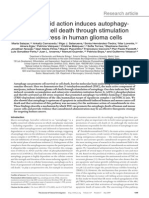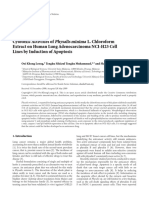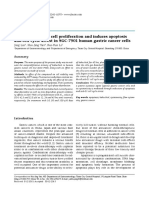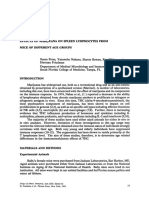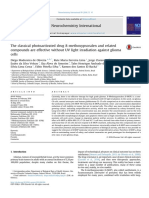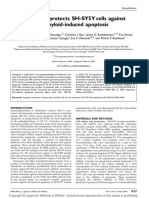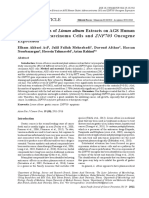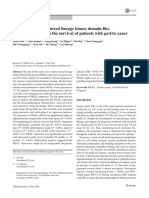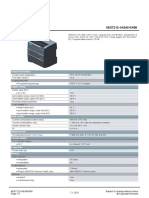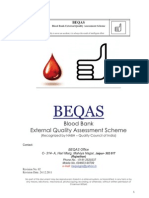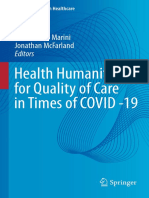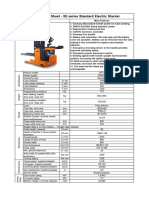Magnolol-Induced H460 Cells Death Via Autophagy But Not Apoptosis
Magnolol-Induced H460 Cells Death Via Autophagy But Not Apoptosis
Uploaded by
Chivis MoralesCopyright:
Available Formats
Magnolol-Induced H460 Cells Death Via Autophagy But Not Apoptosis
Magnolol-Induced H460 Cells Death Via Autophagy But Not Apoptosis
Uploaded by
Chivis MoralesOriginal Title
Copyright
Available Formats
Share this document
Did you find this document useful?
Is this content inappropriate?
Copyright:
Available Formats
Magnolol-Induced H460 Cells Death Via Autophagy But Not Apoptosis
Magnolol-Induced H460 Cells Death Via Autophagy But Not Apoptosis
Uploaded by
Chivis MoralesCopyright:
Available Formats
Arch Pharm Res Vol 30, No 12, 1566-1574, 2007
1566
http://apr.psk.or.kr
Magnolol-Induced H460 Cells Death via Autophagy but Not
Apoptosis
Hai-bo Li, Xin Yi
1
, Jian-mei Gao
2
, Xi-xiang Ying
3
, Hong-quan Guan, and Jian-chun Li
2
School of Basic Medical Sciences, Liaoning University of TCM, 79 Chongshan East Road, Shenyang 110032,
China,
1
Department of pathobiology, Institute of Basic Medical Sciences, Taiping Road 27, Beijing 100850, China,
2
Department of Pharmacy, Shenyang Pharmaceutical University, Wenhua Road 103, Shenyang 110016, China, and
3
School of Pharmacy, Liaoning University of TCM, Chongshan East Road 79, Shenyang 110032, China
(Received May 28, 2007)
We have reported that the protective effect of Magnolol on TBHP-induced injury in human non-
small lung cancer H460 cells is partially via a p53 dependent mechanism. In this study, we
found that Magnolol displayed a stimulatory effect at low concentrations (20 M) whilst inhibi-
tory effect at high concentrations (40 M) in H460 cells. To investigate the mechanism of
inducing the biphasic effect in H460 cells with Magnolol, we showed that Magnolol stimulated
DNA synthesis at low concentrations and displayed an inhibition effect at high concentrations
in H460 cells. More importantly, the inhibition of DNA synthesis was accompanied by the S
phase cell cycle arrest and the appearance of intense intracytoplasmic vacuoles. These vacu-
oles can be labeled by autophagic marker monodansylcadaverin (MDC), 3-methyladenine (3-
MA), an inhibitor of autophagy, was able to inhibit the occurrence of autophagy. The results of
the LDH activity assay and TUNEL assay also showed that Magnolol at high concentrations
inhibiting H460 cell growth was not via apoptotic pathway. Furthermore, accompanied by the
occurrence of autophagy, the expression of phospho-Akt was down-regulated but PTEN signif-
icantly was up-regulated. In conclusion, Magnolol induces H460 cells death by autophagy but
not apoptotic pathway. Blockade of PI3K/PTEN/Akt pathway is maybe related to Magnolol-
induced autophagy. Autophagic cells death induction by Magnolol underlines the potential util-
ity of its induction as a new cancer treatment modality.
Key words: Magnolol, H460, Autophagy, Apoptosis
INTRODUCTION
Apoptosis, or programmed cell death (PCD), is a cell-
intrinsic mechanism for suicide that is regulated by a variety
of cellular signaling pathways. Historically, morphologic
criteria have been used to identify two types of PCD,
apoptosis and autophagic cell death (Mary et al., 2004).
Clarke and his colleagues suggested that autophagic (or
type 2) death was different from apoptotic (type 1) death
(Bowen et al., 1996; Zakeri and Ahuja, 1994). Autophagy
is a well characterized mechanism whereby eukaryotic
cells degrade parts of their own cytoplasm and organelles
(Bursch et al., 1994). Morphological and biochemical
studies have proved that portions of cytoplasm are first
sequestered by a double membrane-bound vacuole (auto-
phagosome) originating from the endoplasmic reticulum
(ER), resulting in the digestion of self-material by lysosomal
hydrolases (Dunn, 1990). It not only plays an essential role
during starvation, cellular differentiation, cell death, aging
and innate immunity but also describes as a prominent
feature of cell death during embryonic development (Bowen
et al., 1996). Other effects for autophagy have also been
discovered, such as presentation of endogenous antigens
and degradation of invasive bacteria (Mizushima, 2005). In
addition, autophagy plays dual roles, which is a mechanism
involved in both cell survival and cell death (Codogno and
Meijer, 2005). Recently, reports showed that some agents
may exert their antitumor effect on tumor cells by inducing
autophagy. And the treatment combining a mTOR inhibi-
tor with PI3K or Akt inhibitor can overcome the resistance
of tumor cells to a mTOR inhibitor by stimulating autophagy
(Iwamaru et al., 2007). These results indicated that induc-
ing autophagy may be a promising new approach for treat-
Correspondence to: Jian-chun Li, Department of Pharmacy, Shen-
Yang Pharmaceutical University, Wenhua Road 103, ShenYang
110016, China
Tel: 86-24-31207082, Fax: 86-24-31207071
E-mail: longqiaoqian@gmail.com
Magnolol-induced H460 Cells Death via Autophagy but Not Apoptosis 1567
ing tumor cells.
Magnolol is isolated from the stem bark of Magnolia sp.,
which has been used to treat for cough, diarrhea, and al-
lergic rhinitis. As an oriental medicine in China, Korea, and
Japan, several recent reports have proved that Magnolol
has several medicinal functions, such as an anxiolytic,
antiinflammatory effect (Shih et al., 2004), antimicrobial
activity against several microorganisms (Chang et al.,
1998; Clark et al., 1981; Lin et al., 2001), inhibitory effect
on skin tumor promotion (Konoshima et al., 1991) and
inducing apoptosis in tumor cells (Ikeda and Nagase,
2002). Some studies and our previously study showed
that Magnolol possesses potent antioxidant and free
radical scavenging activities (Haibo Li, inpress, Lee et al.,
2001).
In this study, we found that Magnolol-induced biphasic
effect in H460 cells at different concentration is associat-
ed with regulation of DNA synthesis. More importantly,
Magnolol exerts its antitumor effect by inducing autophagy
but not apoptosis in H460 cells at high concentrations.
MATERIALS AND METHODS
Chemical reagents
Magnolol was purchased from the National Institute for
the Control of Pharmaceutical and Biological Products
(Beijing, China), it was dissolved in dimethylsulfoxide
(DMSO), to make a stock solution and diluted by RPMI-
1640 (Gibco, Grand Island, NY, U.S.A.), before the experi-
ment, DMSO concentration in all cell culture was kept below
0.01%, which had no detectable effect on cell growth or
death. 3[4, 5-dimethylthiazole-2-yl]-2, 5-diphenyltetrazolium
(MTT), trichloroacetic acid (TCA), 3-MA, and MDC was pur-
chased from Sigma (St. Louis, MO, U.S.A.). Fetal bovine
serum (FBS) was from Dalian Biological Reagent (Dalian,
Liaoning, China). Rabbit polyclonal antibodies against
PTEN, Akt, phospho-Akt (ser 473) and horseradish per-
oxidase-conjugated secondary antibody (goat-antirabbit)
were purchased from Santa Cruz Biotechnology (Santa
Cruz, CA, U.S.A.).
Cell culture
H460 cell line was obtained from American Type Culture
Collection (Rockville, MD, U.S.A.). The cells were cultured
in RPMI-1640 medium supplemented with 10% FBS, 2
mM L-glutamine (Gibco, Grand Island, NY, U.S.A.), penicillin
(100 U/mL) and streptomycin (100 mg/mL), and maintained
at 37
o
C with 5% CO
2
in a humidified atmosphere.
MTT assay
Growth inhibition of H460 cells was determined by the
colorimetric MTT cell viability/proliferation assay. In brief,
the cells were incubated in the presence of agents at 37
o
C
for 6, 12, 24, and 48 h. MTT (25 L/well) was added to
each well, and plates were incubated at 37
o
C for 4 h. The
colored formazan product was then dissolved using 150
L of DMSO. Plates were read using the microtiter plate
reader at a wavelength of 492 nm. The percentage of cell
growth inhibition was calculated according to the following
formula:
Inhibition (%)
= [A
492
(control) A
492
(Magnolol)/A
492
(control)] 100%
All of the assays were performed at least in triplicate.
DNA synthesis assay
H460 cells (510
4
/mL) were seeded in each well of 96-
well plates for 6, 12, and 24 h. After treatment, 1.5 mCi/
mL of [methyl-
3
H] thymidine (Amersham, England) was
added in the medium, and the cells were further incubated
for a further 4 h, and the cells were rinsed twice with PBS
and once with ice-cold 10% TCA then incubated in TCA
at 4
o
C for 30 min. Incorporation of radioactive thymidine
was determined by liquid scintillation in a scintillation
counter (TD 5000, Beckman Instruments, CA, U.S.A.) and
defined by comparing the arithmetic mean of disintegra-
tions per minute (dpm) of treated cells with that of the
untreated control cells.
Flow cytometric analysis
H460 cells (510
4
/mL), after treated with different doses
of Magnolol for 24 h, both adherent and floating, were
pelleted and washed with PBS. The cells were fixed in
75% ethanol at 4
o
C overnight. After washing twice with
PBS, the cells were stained with propidium iodine (1.0
mL, 50 mg/L), RNase A (1 g/L) and 0.1% Triton X-100
insodium citrate (3.8 mM), followed by incubation on ice in
the dark for 30 min. Samples were analyzed by a flow
cytometer (Becton Dickinson FACScan, Franklin Lakes,
CA, U.S.A.) with Cell Quest software, which was used to
determine the percentage of cells in different phases of
the cell cycle.
Wright-Giemsa staining assay
H460 cells (510
4
/mL) in RPMI-1640 medium containing
10% FBS were seeded into 6-well culture plates. After
overnight culture, Magnolol was added in the cell culture.
For measurement of chromatin condensation, Magnolol-
treated H460 cells were fixed with Carnoy solution (ethanol :
chloroform : acetic acid 6 : 3 : 1) at room temperature for
10 min then washed and stained with Wright-Giemsa
staining solution (Sigma) at room temperature for 10 min.
Morphology of H460 cell nuclei was observed under a
light microscope (Olympus, Tokyo, Japan).
1568 H.-B. Li et al.
MDC staining of cytoplasmatic vacuoles
Cytoplasmic vacuoles were stained with MDC accord-
ing to the method described elsewhere (Biederbick et al.,
1995). H460 cells growing exponentially in coverslips
were treated with and without 3-MA (20 mM) pretreated
then treated with 80 M of Magnolol for 24 h. The cells
were then exposed to 50 M of MDC at 37
o
C for 1 h and
fixed with 4% paraformaldehyde. Slides were observed
under a fluorescence microscope (Eclipse E400 Nikon,
Japan).
LDH Activity-based cytotoxicity assays
Determination of the percentages of apoptotic and necro-
tic cells was carried out using the LDH activity assay. The
LDH activity (Zhongsheng LDH kit, Beijing, China) was
measured in both floating dead cells and viable adherent
cells. After treated with different doses of Magnolol for 48
h. Floating cells were collected from the culture medium
by centrifugation (240g) at 4
o
C for 5 min. The LDH ob-
tained from the pellets was used as an index of apoptotic
cell death (LDHp). The LDH released in the culture medium
(extracellular LDH, or LDHe) was used as an index of
necrotic death, and the LDH presented in the adherent
viable cells as intracellular LDH (LDHi). The percentages
of apoptotic and necrotic cell death were calculated as
follows:
Apoptosis (%) = LDHp/(LDHp + LDHi + LDHe) 100
Necrosis (%) = LDHe/(LDHp + LDHi + LDHe) 100
Terminal deoxynucleotidyl transferase-mediated
dUTP nick end-labeling (TUNEL) assay
The TUNEL assay was used for detection of DNA strand
breaks. The detection was carried out according to the in-
structions of TACS
TM
2 TdT-DAB In Situ Apoptosis Detec-
tion Kit. Briefly, after treated with Magnolol at different doses
for 48 h, cells were collected, and then cells were rinsed
once with PBS and fixed in 3.7% buffered formaldehyde
at room temperature for 10 min. The fixed sections were
pretreated with 10% H
2
O
2
, and end-labeling was performed
with TdT labeling reaction mix at 37
o
C for 1 h. Nuclei exhi-
biting DNA fragmentation were visualized by incubation in
3,3-diamino benzidine (DAB) for 7 min. At last the section
were counterstained with methyl green and observed by
light microscopy. The nuclei of apoptotic cell were stained
dark brown, TUNEL-positive H460 cells were determined
by randomly counting 100 cells. Cisplatin (5 g/mL) was
used as a positive control to induce apoptosis.
Western blot analysis
H460 cells were treated with0, 20, 40, and 80 M
Magnolol for 24 h. Both adherent and floating cells were
collected and frozen at -80
o
C. Western blot analysis was
performed as previously described with some modifica-
tion. Briefly, H460 cells were lysed on ice in 30 L of im-
munoblotting lysis buffer containing 50 mM Tris-HCl (pH
7.5), 250 mM NaCl, 5 mM EDTA, 1 mM EGTA, 1 mM NaF,
1 mM phenylmethylsulfonyl fluoride, 1 mM dithiothreitol,
20 g/mL leupeptin, 20 g/mL aprotinin, 0.1% Triton X-
100, and 1% SDS for 1 h. After centrifugation at 15,000
g at 4
o
C for 10 min, the supernatants were collected, and
the protein amount in each sample was measured by a
Bio-Rad DC kit (Bio-Rad, Hercules, CA). The equal amount
of sample (50 g of protein) was subjected to electropho-
resis on either 10% or 12% SDS-polyacrylamide gel. Follow-
ing the electrophoresis, protein blots were transferred to a
nitrocellulose membrane. The membrane was blocked with
5% nonfat milk in TBST solution (10 mM Tris-HCl, pH 7.5,
100 mM NaCl and 0.1% Tween 20), and incubated with the
corresponding primary antibodies in the blocking solution
at 4
o
C for 12 h. After washed three times with TBST solu-
tion, the membrane was incubated with horseradish per-
oxidase-conjugated secondary antibody diluted with TBST
solution (1:1000) at room temperature for 1 h. The detected
protein signals were visualized by the enhanced chemilu-
minescence reaction system according to manufacturers
recommendation (Amersham Biosciences, Indianapolis, IN).
Statistical analysis
All results were confirmed in three separate experiments.
Data were analyzed by single-factor analysis of variance,
with P < 0.05 considered to be statistically significant. Data
are expressed as mean SD.
RESULTS
Effect of Magnolol on the growth of H460 cells
H460 cells (110
5
/mL) were evaluated after a continuous
exposure to Magnolol for 6, 12, 24, and 48 h. The results
(Fig. 1) showed that Magnolol presented a biphasic effect
on H460 cells by MTT assay. That is, Magnolol displayed
a stimulatory effect at low concentrations but inhibitory
effect at high concentrations.
Effect of Magnolol on DNA synthesis in H460 cells
To determine whether the biphasic effect is related to
DNA synthesis, H460 cells (110
5
/mL) proliferation capacity
was quantitatively measured by DNA synthesis assay
using [methyl-
3
H] thymidine. Exponentially growing cells
were treated with a broad concentrations range (10-160
M) of Magnolol for 6, 12, 24, and 48 h. The results (Fig. 2)
showed that Magnolol modestly stimulated DNA synthesis
at low concentrations. This stimulatory effect was mainly
observed at the concentrations between 10 and 20 M
and exposure periods of 24 and 48 h. And maximum
stimulation was obtained with 20 M Magnolol treatment
Magnolol-induced H460 Cells Death via Autophagy but Not Apoptosis 1569
for 48 h, reaching values of 130% after exposure to 20
M. Treatment with high concentrations (40-160 M) was,
on the contrary, always associated with the decrease of
the DNA synthesis in this cell line.
Apoptosis is undetectable in H460 cells treated
with Magnolol
Because Manolol was able to inhibit H460 cell growth at
high concentrations, we did a cell cycle analysis using
untreated and treated H460 cells. Cell cycle analysis also
demonstrated that treatment with 80 M Magnolol for 24 h
arrested cell cycle in S phase. In contrast, no significant S
phase arrest was observed in Magnolol treated case with
low concentrations (Fig. 3A). To characterize the Magnolol-
induced H460 cell death, the rates of LDH release were
examined. When H460 cells were cultured with Magnolol
of 0, 20, 40, 80, and 160 M for 48 h, LDH changes were
analyzed. Magnolol (80 and 160 M) treated H460 cells
underwent necrosis, but the untreated cells or treated with
low caoncentrations (20 and 40 M) did not show necrosis
(Fig. 3B). The TUNEL assay also showed that few apoptotic
cells in H460 cells were detected in H460 cells treated
with Magnolol at high concentrations (Fig. 3C). These
results showed that Magnolol inhibited H460 cell growth
was not via apoptotic pathway.
Autophagy is involved in H460 cells treated with
Magnolol at high concentrations
To investigate the cytotoxic effects of Magnolol on H460
cells, the cells were cultured with Magnolol at various
doses for 24 h. Wright-Giemsa staining was carried out
(Fig. 4A). The intense vacuoles was observed in cells
treated with 80 M
Magnolol for 24 h by microscope, which
was not detected in untreated cells and cells at low con-
centrations case. Base on above finding, we speculated
that those vacuoles might be autophagosome. To test our
hypothesis, 3-MA, a specific inhibitor of early stage of the
autophagic process (Seglen and Gordon, 1982), was em-
ployed. It was also reported to inhibit drug-induced auto-
phagy in some cancer cell lines (Bursch et al., 1996, Jia et
al., 1997). H460 cells were pre-incubated with 3-MA of 0,
5, 10, and 20 mM for 10 h then treated with 80 M Magnolol
for 24 h, and autophagy was inhibited (Fig. 4B). To further
confirm this result, MDC was also employed, which has
been reported to be a selective marker for autophagic
vacuoles (Biederbick et al., 1995). Measurement of MDC
incorporation is a rapid, convenient means to assay auto-
phagy in cultured cells (Pattingre et al., 2004). The result
showed that Magnolol-induced cytoplasmic vacuoles can
be labelled by MDC in H460 cells, indicating that morpho-
logic changes induced by Magnolol were related to auto-
phagy (Fig. 4C). To quantify the number of MDC labeled
cells after they were treated with Magnolol, we determined
the percentage of autophagic cells out of 200 that had
MDC-labeled vacuoles. As shown in Fig. 4D, treatment
with 80 M Magnolol induced autophagy in H460 cells.
Magnolol treatment significantly increased the incidence
of autophagy in H460 cells compared with the control (P <
0.05). These results suggested that inhibition of H460 cell
growth with Magnolol treatment was associated with the
induction of autophagy.
Effect of PTEN and Akt on Magnolol-treated H460
cell
PTEN is a multifunctional phosphatase whose major
Fig. 1. Cytotoxic effects of Magnolol on H460 cells. The cells were
treated with various doses of Magnolol for 6, 12, 24, and 48 h. The
inhibition ratio of cell growth was determined by MTT assay. Results
are represented as meanSD, n = 3.
Fig. 2. Effect of Magnolol on DNA synthesis and viability of H460 cells.
The cells were treated with Magnolol of 0, 10, 20, 40, 80, and 160 M
for 6, 12, and 24 h. DNA synthesis of H460 cells was determined by
the [
3
H]-thymidine incorporation assay. The results are represented as
meanSD, n = 3.
1570 H.-B. Li et al.
Fig. 3. Apoptosis detection in H460 cells treated with Magnolol. A, H460 cells were treated with 0 (a), 20 (b), 40 (c), and 80 M (d) Magnolol for 24
h, and cell cycle was analyzed with Flow cytometric. B, The cells were treated with Magnolol at indicated doses for 48 h. The cell death rate was
measured by the LDH activity-based assay. C, Apoptotic detection in Magnolol treated H460 cells using TUNEL staining. After treatment with or
without indicated Magnolol or Cisplatin (10 g/mL) for 48 h, H460 cells were fixed, labeled with Br-dUTP, and stained with an anti-Br-dUTP
antibody for a TUNEL analysis. The percentage of apoptosis was calculated as the percentage of TUNEL-positive cells out of 200 cells from each
case. MeanSD, n = 3.
Magnolol-induced H460 Cells Death via Autophagy but Not Apoptosis 1571
substrate is phosphatidylinositol-3,4,5-trisphosphate (PIP3),
a lipid second messenger molecule. PIP3 activates numer-
ous downstream targets, including the serine-threonine
kinase PKB/Akt, which is involved in anti-apoptosis, prolife-
ration, and oncogenesis (Kishimoto et al., 2007). H460
cells incubated with Magnolol of 20, 40, and 80 M for
24
h, as showed in Fig. 5, the expression of phospho-Akt was
up-regulated at low concentrations and down-regulated at
high concentrations of Magnolol, while the level of total Akt
was not change. The expression of PTEN was up-regulated
at high concentrations of Magnolol. These result indicated
that PTEN and phospho-Akt were maybe related to both
proliferation and autophagy.
Fig. 4. Autophagy detection in H460 cells treated with Magnolol. A, Magnolol induced morphologic changes of H460. Treated with 0 (a), 20 (b), 40
(c), and 80 M (d) for 24 h. Scal bar: 10 M, (Wright-Giemsa stain, 400). B, The effect of 3-MA on autophagy. The cells were pretreated with 3-
MA at 0, 5, 10, 20, and 40 mM for
10 h then treated with Magnolol of 80 M
for 24 h.
The inhibition ratio of cell growth was determined by MTT
assay. The results are represented as meanSD, n = 3. Scal bar: 10 M. C, MDC staining of cytoplasmic vacuoles in H460 cells induced by
Magnolol. Untreated H460 cells of fluorescent microscopy (400) (a), treated 80 M Magnolol alone for 24 h (b), pre-treated with 3-MA at 20 mM
for 10 h then treated with Magnolol of 80 M for 24 h (c), and treated 20 mM 3-MA alone for 24 h(d). Scal bar: 20 M. D, quantification of cells
undergoing autophagy. H460 cells treated with various Magnolol for 24 h then were stained with MDA (0.05 mM) and observed under a
fluorescence microscope. The autophagic index was calculated as the percentage of MDC-positive cells out of 200 cells from each case. * P < 0.05
vs control.
Fig. 5. The expression of PTEN, AKT and phospho-AKT protein were
detected by Western blot analysis. The cells were treated with different
concentrations of Magnolol for 24 h. The changes of PTEN, AKT and
phospho-AKT expression were analyzed by western blotting. Repre-
sentative blots of at least 3 independent experiments are shown.
1572 H.-B. Li et al.
DISCUSSION
In the present work, it was noticed that Magnolol exhi-
bited a biphasic effect in H460 cells, stimulating prolifera-
tion at low concentrations and inhibiting proliferation at
high concentrations after treated for 24 h. These results
prompted us to undertake a more thorough study of these
findings. The experiments further confirmed that Magnolol
stimulated DNA synthesis at low concentrations and inhi-
bited DNA synthesis at high concentrations. Moreover, the
decline in DNA synthesis caused by high concentrations
of Magnolol was accompanied by the appearance of the
intense intracytoplasmic vacuoles in Wright-Giemsa stain-
ing. Since, similar vacuoles have been described in the
autophagic process (Pedro et al., 2006), we characterized
the vacuoles induced by Magnolol in H460 cells with the
autophagic marker MDC. The MDC stain test also confirm-
ed the same result. 3-MA, a specific inhibitor of autophagy,
potently suppressed Magnolol-induced autophagy. When
autophagy was suppressed by 3-MA in Magnolol-treated
H460 cells, the cell death ratio significantly decreased
compared with the Magnolol alone treatment case, further
confirmed that autophagy was involved in Magnolol treated
H460 cells at high concentrations. Autophagy probably
plays both the promotion and prevention of cancer, and its
role may be altered during tumor progression. Inhibition of
autophagy may allow the continuous growth of precancer-
ous cells, and autophagy can act as a suppressor of can-
cer (Gozuacik and Kimchi, 2004; Pattingre et al., 2003).
Autophagy/cancer relationship is the observation that some
malignant cell types respond to anticancer agents by trig-
gering autophagy, indicating the potential utility of auto-
phagic cell death induction in cancer therapy (Gozuacik
and Kimchi, 2004; Bursch et al., 1996). In the present
study, LDH assay showed that the high concentrations of
Magnolol was a cytotoic rather than a cytostatic drug in
this cell line after the H460 was treated with Magnolol for
24 and 48 h. Therefore, we conclude that Magnolol induces
cell death mainly through the autophagy, and apoptotic
process is negligible. This is different from some studies
showed that Magnolol induces G
1
phase arrest in cultured
colon and induces cell apoptosis in liver cancer cells (Lin
et al., 2001, 2002).
It is known that PI3K/Akt (or PKB) signaling pathway
plays crucial role in cells proliferation and death. PI3K
family members are classified into three groups according
to their structures and substrate specificities. Class I and
III PI3Ks act antagonistically at different steps of autophagy
(Petiot et al., 2000). Class III PI3K is probably engaged in
the control of the formation of autophagic vacuoles by as-
sociation with other proteins recruited to cytoplasmic mem-
brane. By contrast, the plasma membrane associated
class I PI3K would be required to transduce a negative
signal for the biogenesis of the autophagic vacuole (Petiot
et al., 2000). 3-MA was recently classified as a class III
PI3K inhibitor (Stroikin et al., 2004). 3-MA can suppress
Magnolol-induced autophagy. Therefore, we suggest that
the effect of 3-MA on Magnolol-induced autophagy may
be due to inhibition of the class III PI3K, the class III PI3K
stimulates autophagy. Class I PI3K and the downstream
kinase Akt activation initiates a cascade of events that
promote growth factor production, cell division and survival
(Gerber et al., 1998, Larsen and Sulzer, 2002). John Bro-
gnard and his colleagues demonstrated that Akt was
activated in most NSCLC cell lines (Brognard et al., 2001).
As expected, treatment with Magnolol increased the Akt
phosphorylation at low concentrations and decreased at
high concentrations. The result indicated there are some
links between Class I PI3K/Akt and autophagy.
The tumor suppressor PTEN possesses both protein and
lipid phosphatase activities, preferentially dephosphorylates
at D3 position phosphatidylinositol (3, 4, 5)-trisphosphate
(PIP3). PIP3 is a product of class I PI3K and can activate
Akt (Rani et al., 2002). It is one of three enzymes known to
dephosphorylate PIP3, suggesting that PTEN may func-
tion as a direct antagonist of PI3K and PIP3-dependent
signaling (Lee et al., 1999). Furthermore, PTEN also reg-
ulates Akt activity through its lipid phosphatase function
(Stambolic et al., 2001). Moreover PTEN, via its lipid
phosphatase activity, is involved in the signaling control of
autophagy, together with the downstream acting Akt (Arico
et al., 2001). In our study, the expression PTEN increased
at high concentrations. The results indicate that Class I
PI3K/Akt signaling pathway plays key role in H460 cells
proliferation and autophagy. Hence, autophagy in Magnolol
treated H460 cell is controlled by class III and class I
PI3K, but they are in opposite directions.
In summary, in the present studies we have demon-
strated for the first time that Magnolol presents a biphasic
effect in H460 cells, which shows stimulatory effect of DNA
synthesis at low concentrations and an inhibitory effect at
high concentrations. High concentrations of Magnolol in-
duces autophagy, and the apoptotic process is negligible.
Magnolol promoting proliferation and inducing autophagy
is dependent on Class I PI3K/PTEN/Akt pathways the
class III PI3K stimulates autophagy in this process. Those
findings represent a potential mechanism that Magnolol
may confer lung cancer chemotherapeutic effect and sug-
gest that further characterization of Magnolol as anticancer
agent might be warranted.
REFERENCES
Arico, S., Petiot, A., Bauvy, C., Dubbelhuis, P. F., Meijer, A. J.,
Codogno, P., and Ogier-denis, E., The tumor suppressor
PTEN positively regulates macroautophagy by inhibiting the
Magnolol-induced H460 Cells Death via Autophagy but Not Apoptosis 1573
phosphatidylinositol 3-kinase/protein kinase B pathway. J.
Biol. Chem, 276, 35243-35246 (2001).
Abraham M. C. and Shaham, S., Death without caspases,
caspases without death. TRENDS in Cell Biology, 14, 184-
192 (2004).
Biederbick, A., Kern, H. F., and Elsasser, H. P., Monodansyl-
cadaverine (MDC) is a specific in vivo marker for autophagic
vacuoles. Eur. J. Cell Biol., 66, 3-14 (1995).
Bowen, I. D., Mullarkey, K., and Morgan, S. M., Programmed
cell death during metamorphosis in the blow-fly Calliphora
vomitoria. Microsc. Res. Tech., 34, 202-217 (1996).
Brognard, J., Clark, A. S., Ni, Y., and Dennis, P. A., Akt/protein
kinase B is constitutively active in non-small cell lung cancer
cells and promotes cellular survival and resistance to
chemotherapy and radiation. Cancer Res., 61, 3986-3997
(2001).
Bursch, W., Ellinger, A., Kienzl, H., Torok, L., Pandey, S.,
Sikorska, M., Walker, R., and Hermann, R. S., Active cell
death induced by the anti-estrogens tamoxifen and ICI 164
384 in human mammary carcinoma cells (MCF-7) in culture:
the role of autophagy. Carcinogenesis, 17, 1595-607 (1996).
Bursch, W., Grasl-kraupp, B., Ellinger, A., Torok, L., Kienzl, H.,
Mullauer, L., and Schulte-hermann, R., Active cell death: role
in hepatocarcinogenesis and subtypes. Biochem. Cell Biol.,
72, 669-675 (1994).
Chang, B., Lee, Y., Ku, Y., Bae, K., and Chung, C., Antimicrobial
activity of magnolol and honokiol against periodontopathic
microorganisms. Planta. Med., 64, 367-369 (1998).
Clark, A. M., El-feraly, F. S., and Li, W. S., Antimicrobial activity
of phenolic constituents of Magnolia grandiflora L. J. Pharm.
Sci., 70, 951-952 (1981).
Codogno, P. and Meijer, A. J., Autophagy and signaling: their
role in cell survival and cell death. Cell Death Differ, 12 Suppl
2, 1509-1518 (2005).
Dunn, W. A. Jr., Studies on the mechanisms of autophagy:
formation of the autophagic vacuole. J. Cell Biol., 110, 1923-
1933 (1990).
Gerber, H. P., Dixit, V., and Ferrara, N., Vascular endothelial
growth factor induces expression of the antiapoptotic pro-
teins Bcl-2 and A1 in vascular endothelial cells. J. Biol.
Chem., 273, 13313-13316 (1998).
Gozuacik, D. and Kimchi, A., Autophagy as a cell death and
tumor suppressor mechanism. Oncogene, 23, 2891-2906
(2004).
Li, H., Gao, J.-M., Ying, X., Wang, S., and Li, J., Protective
Effect of Magnolol on TBHP-Induced Injury in H460 Cells
Partially via a p53 Dependent Mechanism (inpress).
ikeda, K. and Nagase, H., Magnolol has the ability to induce
apoptosis in tumor cells. Biol. Pharm. Bull., 25, 1546-1549
(2002).
Iwamaru, A., Kondo, Y., Iwado, E., Aoki, H., Fujiwara, K., Yoko-
yama, T., Mills, G. B., and Kondo, S., Silencing mammalian
target of rapamycin signaling by small interfering RNA
enhances rapamycin-induced autophagy in malignant glioma
cells. Oncogene, 26, 1840-1851 (2007).
Jia, L., Dourmashkin, R. R., Allen, P. D., Gray, A. B., Newland,
A. C., and Kelsey, S. M., Inhibition of autophagy abrogates
tumour necrosis factor alpha induced apoptosis in human T-
lymphoblastic leukaemic cells. Br. J. Haematol., 98, 673-685
(1997).
Kishimoto, H., Ohteki, T., Yajima, N., Kawahara, K., Natsui, M.,
Kawarasaki, S., Hamada, K., Horie, Y., Kubo, Y., Arase, S.,
Taniguchi, M., Vanhaesebroeck, B., Mak, T. W., Nakano, T.,
Koyasu, S., Sasaki, T., and Suzuki, A., The Pten/PI3K pathway
governs the homeostasis of V{alpha}14iNKT cells. Blood,
109, 3316-3324 (2007).
Konoshima, T., Kozuka, M., Tokuda, H., Nishino, H., Iwashima,
A., Haruna, M., Ito, K., and Tanabe, M., Studies on inhibitors
of skin tumor promotion, IX. Neolignans from Magnolia
officinalis. J. Nat. Prod., 54, 816-822 (1991).
Larsen, K. E. and Sulzer, D., Autophagy in neurons: a review.
Histol Histopathol, 17, 897-908 (2002).
Lee, J. O., Yang, H., Georgescu, M. M., Di Cristofano, A.,
Maehama, T., Shi, Y., Dixon, J. E., Pandolfi, P., and Pavletich,
N. P., Crystal structure of the PTEN tumor suppressor:
implications for its phosphoinositide phosphatase activity and
membrane association. Cell, 99, 323-334 (1999).
LEe, Y. M., Hsiao, G., Chen, H. R., Chen, Y. C., Sheu, J. R., and
Yen, M. H., Magnolol reduces myocardial ischemia/reper-
fusion injury via neutrophil inhibition in rats. Eur. J. Pharmacol.,
422, 159-167 (2001).
Lin, S. Y., Chang, Y. T., Liu, J. D., Yu, C. H., Ho, Y. S., Lee, Y. H.,
and Lee, W. S., Molecular mechanisms of apoptosis induced
by magnolol in colon and liver cancer cells. Mol. Carcinog,
32, 73-83 (2001).
Lin, S. Y., Liu, J. D., Chang, H. C., Yeh, S. D., Lin, C. H., and
Lee, W. S., Magnolol suppresses proliferation of cultured
human colon and liver cancer cells by inhibiting DNA
synthesis and activating apoptosis. J. Cell Biochem., 84,
532-544 (2002).
Mizushima, N., The pleiotropic role of autophagy: from protein
metabolism to bactericide. Cell Death Differ, 12 Suppl 2,
1535-1541 (2005).
Pattingre, S., Bauvy, C., and Codogno, P., Amino acids interfere
with the ERK1/2-dependent control of macroautophagy by
controlling the activation of Raf-1 in human colon cancer HT-
29 cells. J. Biol. Chem., 278, 16667-16674 (2003).
Pattingre, S., Petiot, A., and Codogno, P., Analyses of Galpha-
interacting protein and activator of G-protein-signaling-3
functions in macroautophagy. Methods Enzymol, 390, 17-31
(2004).
Pedro, M., Lourenco, C. F., Cidade, H., Kijjoa, A., Pinto, M., and
Nascimento, M. S., Effects of natural prenylated flavones in
the phenotypical ER (+) MCF-7 and ER (-) MDA-MB-231
human breast cancer cells. Toxicol. Lett, 164, 24-36 (2006).
PEtiot, A., Ogier-denis, E., Blommaart, E. F., Meijer, A. J., and
1574 H.-B. Li et al.
Codogno, P., Distinct classes of phosphatidylinositol 3'-
kinases are involved in signaling pathways that control
macroautophagy in HT-29 cells. J Biol Chem, 275, 992-998
(2000).
Rani, M. R., Hibbert, L., Sizemore, N., Stark, G. R., and Ransohoff,
R. M., Requirement of phosphoinositide 3-kinase and Akt for
interferon-beta-mediated induction of the beta-R1 (SCYB11)
gene. J. Biol. Chem., 277, 38456-38461 (2002).
Seglen, P. O. and Gordon, P. B., 3-Methyladenine: specific
inhibitor of autophagic/lysosomal protein degradation in
isolated rat hepatocytes. Proc. Natl. Acad. Sci. U.S.A., 79,
1889-1892 (1982).
Shih, H. C., Wei, Y. H., and Lee, C. H., Magnolol alters the
course of endotoxin tolerance and provides early protection
against endotoxin challenge following sublethal hemorrhage
in rats. Shock, 22, 358-363 (2004).
Stambolic, V., Macpherson, D., Sas, D., Lin, Y., Snow, B., Jang,
Y., Benchimol, S., and Mak, T. W., Regulation of PTEN trans-
cription by p53. Mol Cell, 8, 317-325 (2001).
Stroikin, Y., Dalen, H., Loof, S., and Terman, A., Inhibition of
autophagy with 3-methyladenine results in impaired turnover
of lysosomes and accumulation of lipofuscin-like material.
Eur. J. Cell. Biol., 83, 583-590 (2004).
Zakeri, Z. F. and Ahuja, H. S., Apoptotic cell death in the limb
and its relationship to pattern formation. Biochem. Cell Biol.,
72, 603-613 (1994).
You might also like
- International Financial Management MCQDocument5 pagesInternational Financial Management MCQAshish Patel100% (6)
- More Zapper Frequencies PDFDocument1 pageMore Zapper Frequencies PDFRobert MaximilianNo ratings yet
- God Wants You Well Booklet - Digital Version PDFDocument32 pagesGod Wants You Well Booklet - Digital Version PDFSTEFAN RAMJITSINGH100% (7)
- Food and Chemical Toxicology: Kyoung Jin Nho, Jin Mi Chun, Ho Kyoung KimDocument10 pagesFood and Chemical Toxicology: Kyoung Jin Nho, Jin Mi Chun, Ho Kyoung KimMd Jahidul IslamNo ratings yet
- JCI37948 v2Document14 pagesJCI37948 v2AJ FabrizioNo ratings yet
- Cytotoxic Activity of Stem of Pycnarrhena Cauliflora Through ApopDocument6 pagesCytotoxic Activity of Stem of Pycnarrhena Cauliflora Through ApophuwlacNo ratings yet
- In Vitro Anticancer Activity of a Nonpolar FractioDocument13 pagesIn Vitro Anticancer Activity of a Nonpolar Fractioanhngthuy20No ratings yet
- Original Article: Physalis MinimaDocument11 pagesOriginal Article: Physalis MinimaJulia DeleonNo ratings yet
- Efek Pluchea Indica PD CoxDocument4 pagesEfek Pluchea Indica PD CoxSiti Nur Aliyatul AzizahNo ratings yet
- Wang Et Al-2012-Journal of Pineal ResearchDocument8 pagesWang Et Al-2012-Journal of Pineal ResearchDionisio MesyeNo ratings yet
- Bakuchiol Inhibits Cell Proliferation and Induces Apoptosis and Cell Cycle Arrest in SGC-7901 Human Gastric Cancer CellsDocument6 pagesBakuchiol Inhibits Cell Proliferation and Induces Apoptosis and Cell Cycle Arrest in SGC-7901 Human Gastric Cancer CellsFarhana AnuarNo ratings yet
- Antikanker 3Document5 pagesAntikanker 3Namira NaaziahNo ratings yet
- Effect of Low Dose Quercetin and CancerDocument21 pagesEffect of Low Dose Quercetin and CancerMetcher Maa AkhiNo ratings yet
- The Tyrosine Kinase Inhibitor Nilotinib Is More Efficient Than Mitotane in Decreasing Cell Viability in Spheroids Prepared From Adrenocortical Carcinoma CellsDocument16 pagesThe Tyrosine Kinase Inhibitor Nilotinib Is More Efficient Than Mitotane in Decreasing Cell Viability in Spheroids Prepared From Adrenocortical Carcinoma CellsElaine SilveiraNo ratings yet
- Cao 2011Document6 pagesCao 2011taoufik akabliNo ratings yet
- Research Article Viola Tricolor Induces Apoptosis in Cancer Cells and ExhibitsDocument9 pagesResearch Article Viola Tricolor Induces Apoptosis in Cancer Cells and ExhibitsEliasDraNo ratings yet
- Fluoxtine InducedDocument7 pagesFluoxtine InducedsufaNo ratings yet
- PDFDocument9 pagesPDFsrinivas rao kNo ratings yet
- JNCI J Natl Cancer Inst 1997 Ahmad 1881 6Document6 pagesJNCI J Natl Cancer Inst 1997 Ahmad 1881 6Satria Bayu PratamaNo ratings yet
- 39 809Document7 pages39 809windyndaNo ratings yet
- Maslinic Acid A Triterpene From Olive AfDocument12 pagesMaslinic Acid A Triterpene From Olive AfLeoncio LucenaNo ratings yet
- Introduction Cancer Is Abnormal Cell Growth That Proliferates in An Uncontrolled Pattern That Allows It To Continue and SpreadDocument10 pagesIntroduction Cancer Is Abnormal Cell Growth That Proliferates in An Uncontrolled Pattern That Allows It To Continue and SpreadmrlakshyaranaNo ratings yet
- EFFECfS OF MARUUANA ON SPLEEN LYMPHOCYTES FROM MICE OF DIFFERENT AGE GROUPSDocument2 pagesEFFECfS OF MARUUANA ON SPLEEN LYMPHOCYTES FROM MICE OF DIFFERENT AGE GROUPScatamc90No ratings yet
- NIH Public Access: Author ManuscriptDocument10 pagesNIH Public Access: Author ManuscriptSyahrul Hamidi NasutionNo ratings yet
- Asadi Khiavi BioImpacts 2011 1 2Document7 pagesAsadi Khiavi BioImpacts 2011 1 2farhadNo ratings yet
- Terminalia Catappa: Research ArticleDocument12 pagesTerminalia Catappa: Research ArticleAnonymous HPjzZkWJbvNo ratings yet
- Prajitha2016 PDFDocument11 pagesPrajitha2016 PDFfitriana ibrahimNo ratings yet
- Hoat Tinh Cua AlbaconolDocument8 pagesHoat Tinh Cua Albaconolngoclinh87No ratings yet
- Cannabinoid Action On CancerDocument14 pagesCannabinoid Action On CanceryourgovliesNo ratings yet
- Ganoderic Acid T From Ganoderma Mycelia Induces Mitochondria Mediated Apoptosis in Lung Cancer CellsDocument7 pagesGanoderic Acid T From Ganoderma Mycelia Induces Mitochondria Mediated Apoptosis in Lung Cancer CellsGandalfNo ratings yet
- Momordica CharantiaDocument13 pagesMomordica CharantiaAsher2225No ratings yet
- European Journal of Pharmaceutical SciencesDocument6 pagesEuropean Journal of Pharmaceutical SciencesIsaac ClarckeNo ratings yet
- Citosol (Thiamylal Sodium) Triggers Apoptosis and Affects Gene Expressions of Murine Leukemia RAW 264.7 Cells - RS-C Wu, C-S YuDocument1 pageCitosol (Thiamylal Sodium) Triggers Apoptosis and Affects Gene Expressions of Murine Leukemia RAW 264.7 Cells - RS-C Wu, C-S YuAlondra MaldonadoNo ratings yet
- 31 Humphrey Mitochondrial Initiated Thimerosal 2005Document10 pages31 Humphrey Mitochondrial Initiated Thimerosal 2005Ita Zuñiga AlfaroNo ratings yet
- Ethanolic Extract of Doxorubicin On MCF-7 Breast Cancer CellDocument9 pagesEthanolic Extract of Doxorubicin On MCF-7 Breast Cancer Cellnugroho akhbarNo ratings yet
- Richard B. Rothman Et Al - Salvinorin A: Allosteric Interactions at The Mu-Opioid ReceptorDocument10 pagesRichard B. Rothman Et Al - Salvinorin A: Allosteric Interactions at The Mu-Opioid ReceptorNeerFamNo ratings yet
- Toxins in SpicesDocument5 pagesToxins in SpicestatarasanurazvanNo ratings yet
- Inhibición de La Angiogénesis Tumoral Por CannabinoidesDocument16 pagesInhibición de La Angiogénesis Tumoral Por CannabinoidesjessicaNo ratings yet
- Effect of Taxol From Pestalotiopsis Mangiferae On A549 Cells-In Vitro StudyDocument9 pagesEffect of Taxol From Pestalotiopsis Mangiferae On A549 Cells-In Vitro StudyLizbethNo ratings yet
- CD 44Document7 pagesCD 44Carolina TGNo ratings yet
- 2016 - CEL C6 - PDFDocument9 pages2016 - CEL C6 - PDFSARANo ratings yet
- Bauhinia KockianaDocument9 pagesBauhinia Kockianaromanauli situmorangNo ratings yet
- Nticancer ESEARCH 27: 2175-2184 (2007) : AbstractDocument9 pagesNticancer ESEARCH 27: 2175-2184 (2007) : AbstracttoanphandlNo ratings yet
- C y T o T o X I C A C T I V I T y o F M e T H A N o L I C e X T R A C T o F S T e M B A R K o F LDocument8 pagesC y T o T o X I C A C T I V I T y o F M e T H A N o L I C e X T R A C T o F S T e M B A R K o F LlinubinoiNo ratings yet
- Voacanga RL UpdatedDocument8 pagesVoacanga RL UpdatedRonel HagosNo ratings yet
- Book 2011Document102 pagesBook 2011fdsjklsdfxsdfsdfNo ratings yet
- Hongzhuan Xuan, Zhen Li, Haiyue Yan, Qing Sang, Kai Wang, Qingtao He, Yuanjun WangDocument29 pagesHongzhuan Xuan, Zhen Li, Haiyue Yan, Qing Sang, Kai Wang, Qingtao He, Yuanjun WangTim WongNo ratings yet
- Effect of Autophagy Inhibition On Chemotherapy-Induced Apoptosis in A549 Lung Cancer CellsDocument5 pagesEffect of Autophagy Inhibition On Chemotherapy-Induced Apoptosis in A549 Lung Cancer Cellsfranciscrick69No ratings yet
- International Journal of Cancer Volume 85 Issue 3 2000Document8 pagesInternational Journal of Cancer Volume 85 Issue 3 2000BenePicarNo ratings yet
- Ssri On CancerDocument7 pagesSsri On CancerArpit SanghaniNo ratings yet
- Pettifer 2004Document4 pagesPettifer 2004BRUNO FERNANDES DA SILVANo ratings yet
- Articulo 3Document8 pagesArticulo 3vanesaNo ratings yet
- ArtículoDocument10 pagesArtículoKaty RamírezNo ratings yet
- Apjcp 19 2911Document6 pagesApjcp 19 2911Arian RahimiNo ratings yet
- Jen-Hung Yang, Te-Chun Hsia, Hsiu-Maan Kuo, Pei-Dawn Lee Chao, Chi-Chung Chou, Yau-Huei Wei, and Jing-Gung ChungDocument9 pagesJen-Hung Yang, Te-Chun Hsia, Hsiu-Maan Kuo, Pei-Dawn Lee Chao, Chi-Chung Chou, Yau-Huei Wei, and Jing-Gung ChungDian Ayu UtamiNo ratings yet
- Antitumor Effects of Cannabidiol, A Nonpsychoactive - 2003 - Uni - of - MilanDocument8 pagesAntitumor Effects of Cannabidiol, A Nonpsychoactive - 2003 - Uni - of - MilanMichael CitronNo ratings yet
- Gentamicin-Induced Apoptosis in Renal Cell Lines and Embryonic Rat FibroblastsDocument0 pagesGentamicin-Induced Apoptosis in Renal Cell Lines and Embryonic Rat FibroblastsCLPHtheoryNo ratings yet
- Ertao 2016Document7 pagesErtao 2016chemistpl420No ratings yet
- Potency of CitrusDocument9 pagesPotency of CitrusYulitha Rempe SampeallaNo ratings yet
- Quer Ce TinaDocument13 pagesQuer Ce Tinanorociel8132No ratings yet
- Tumor Immune Microenvironment in Cancer Progression and Cancer TherapyFrom EverandTumor Immune Microenvironment in Cancer Progression and Cancer TherapyPawel KalinskiNo ratings yet
- Engineering Report For Single Pass Rice Mills/ Corn Mills: General InformationDocument2 pagesEngineering Report For Single Pass Rice Mills/ Corn Mills: General InformationPrincess SalvadorNo ratings yet
- History of ChocolateDocument10 pagesHistory of ChocolateGauravNo ratings yet
- Latihan Olimpiade Bahasa Inggris SDDocument7 pagesLatihan Olimpiade Bahasa Inggris SDGWC OFFICIALNo ratings yet
- 4.4 Climate ChangeDocument6 pages4.4 Climate Changecamila hartmannNo ratings yet
- HVDC ThesisDocument5 pagesHVDC ThesisOnlinePaperWritersSingapore100% (2)
- UHD-III 06 Volume 1 ROV & TMS System Manuals PDFDocument632 pagesUHD-III 06 Volume 1 ROV & TMS System Manuals PDFacrov.ltdNo ratings yet
- Chapter 10. Biodiversity and Healthy SocietyDocument31 pagesChapter 10. Biodiversity and Healthy SocietyKrish TineNo ratings yet
- I SOBERSi SOBERSProspecificationDocument2 pagesI SOBERSi SOBERSProspecificationsariram1823No ratings yet
- Psychology Chapter 2Document5 pagesPsychology Chapter 2kar fangNo ratings yet
- Data Sheet 6ES7212-1AE40-0XB0: General InformationDocument7 pagesData Sheet 6ES7212-1AE40-0XB0: General InformationcrrreisNo ratings yet
- Continuous Venous Oxygen Saturation MonitoringDocument10 pagesContinuous Venous Oxygen Saturation MonitoringydtrgnNo ratings yet
- EQAS General InformationDocument13 pagesEQAS General Informationtanguy_chau100% (1)
- Livestrong - Cycling Around Lance ArmstrongDocument6 pagesLivestrong - Cycling Around Lance ArmstrongJuan Vallejos LealNo ratings yet
- Datacenter ChecklistDocument7 pagesDatacenter ChecklistOluwatomi BabatundeNo ratings yet
- (New Paradigms in Healthcare) Maria Giulia Marini, Jonathan McFarland - Health Humanities For Quality of Care in Times of COVID - 19-Springer (2022)Document175 pages(New Paradigms in Healthcare) Maria Giulia Marini, Jonathan McFarland - Health Humanities For Quality of Care in Times of COVID - 19-Springer (2022)Sofronie MadalinNo ratings yet
- Frenos WabcoDocument61 pagesFrenos WabcoFastcross HondaNo ratings yet
- Technical SheetDocument2 pagesTechnical Sheetdesie yalewNo ratings yet
- De Etsiline CommPact GB.Document2 pagesDe Etsiline CommPact GB.Luke NguyenNo ratings yet
- Band Gap EnergyDocument3 pagesBand Gap Energysantraakash999No ratings yet
- T4a 2023 111058 PDFDocument1 pageT4a 2023 111058 PDFMarryNo ratings yet
- Rebt Discussion Board Case Study and QuestionsDocument3 pagesRebt Discussion Board Case Study and Questionsapi-290174387100% (2)
- Vendor Registration Form New 2Document4 pagesVendor Registration Form New 2amanlubricants769No ratings yet
- Name: Class: 1. Read The Following ID Card. Then, Write A Descriptive Text About HimDocument2 pagesName: Class: 1. Read The Following ID Card. Then, Write A Descriptive Text About HimCahyo KhoirulNo ratings yet
- Iee PPTDocument38 pagesIee PPTmadhulavNo ratings yet
- HSB The Endocrine System Csec NotesDocument4 pagesHSB The Endocrine System Csec NotesGiaaNo ratings yet
- Freee GeeeeDocument47 pagesFreee GeeeeRamon ColonNo ratings yet
- The Geography of Africa: By: Eleanor Joyce City of Salem SchoolsDocument52 pagesThe Geography of Africa: By: Eleanor Joyce City of Salem Schoolsbhaskar rayNo ratings yet




